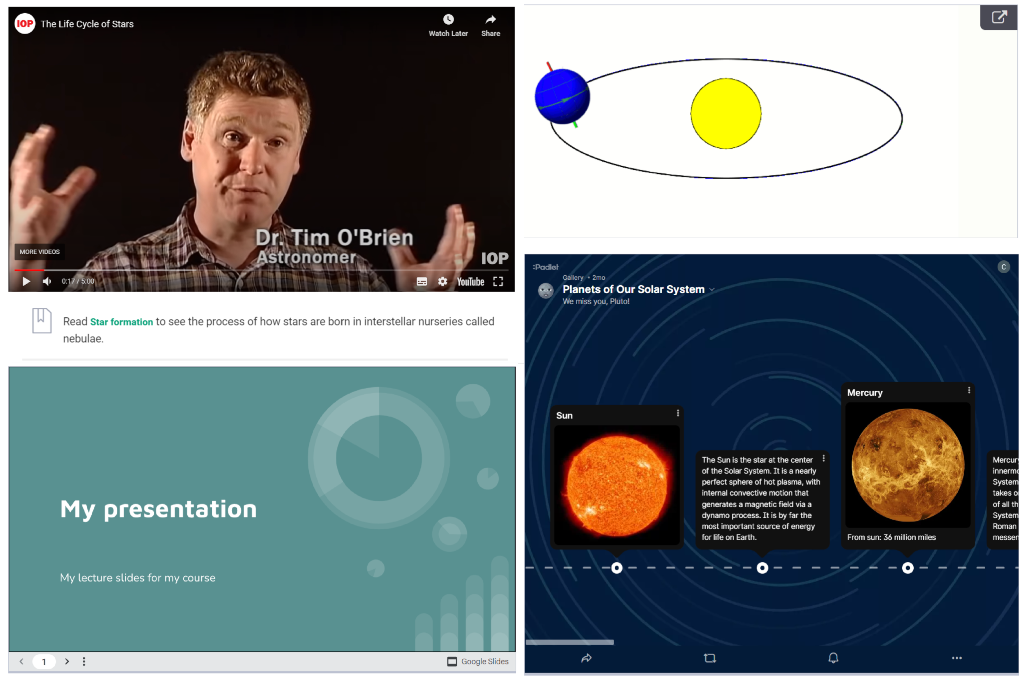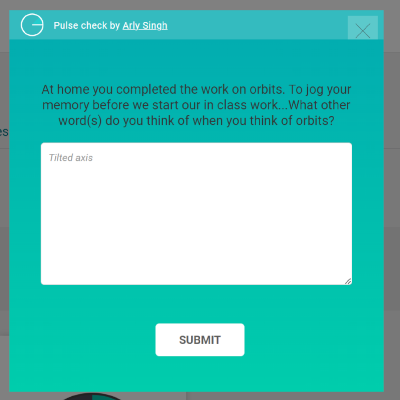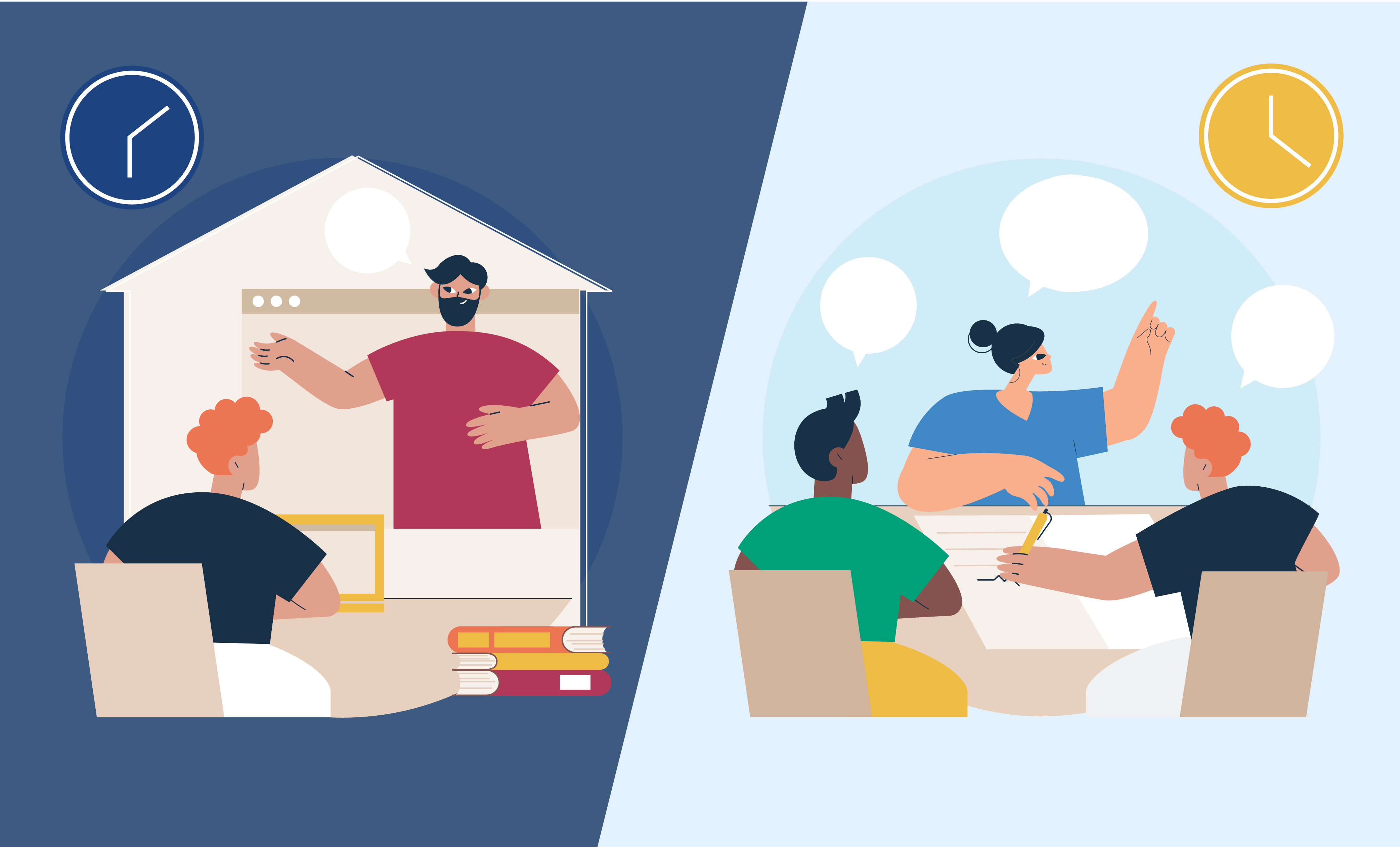Flipped learning flips the traditional instructional process on its head. Instead of the teacher lecturing content and learners doing tasks and problem sets at home, learners get the content of the lecture online (video, article, website, etc.), freeing up face-to-face time for working on tasks and problems.
Flipped learning was my first real foray into blended learning back when I was a high school physics teacher. I had groups of students working on different topics and learning outcomes and so I needed to be able to share my time in class among the different groups.
I uploaded all my presentations and included summary notes, videos and links to further resources. Then, in class, each group had their practice tasks to discuss and work through and I would spend a portion of class time with each group going over any questions from the online content or the problems they were working on in class. It was by no means an exemplary model of flipped learning, but I was grateful it allowed me to offer my learners choice in which topics they wanted to study.
But there are more benefits to flipped learning than just this.
Benefits
One benefit of flipped learning is that it allows learners to do the “content presentation” part more on their terms. If they’re struggling, they can slow things down. They can watch and rewatch (or read and reread) as many times as they like and post any questions about the content publicly or privately. If learners already know the basics of the content, they can skip ahead, or speed things up. They’re not sitting in class getting bored and switching off while you labour over an explanation they already understand.
Flipped learning allows you to shift teacher time to where there is the greatest, added value. The learning that gets focused on in class is the stuff that requires discussion, wrestling with ideas, problem-solving, and feedback. These are the activities where they need you, the expert and coach intervening in real-time, at just the right moment to spur them on or give them that ah-ha moment.
Flipped learning in iQualify
In iQualify, you can upload and/or embed whichever resources you want learners to work through at home.

And, as a facilitator, you can easily see where learners are up to and if they have done what they need to do before class.

You could even use a pulse as an “entry ticket” before or at the beginning of class.

Tip: iQualify is responsive and resizes well for any device, so learners can easily log in and answer on their phones.
A better flip
Flipped learning is a great starting point for blended learning. It does a great job of shifting precious teacher time to higher-value activities like feedback and supporting learners’ problem-solving. But, there are a couple of ways we can make the flip even better.
Make home learning active
One of the traps to fall into (I certainly did) with flipped learning is to have the “home” portion as passive absorption of information. But there's much more to learning than reading, watching or listening. Rather, we need to:
“Give the pupils something to do, not something to learn...” - John Dewey, 1916
So, instead of just uploading your slides and videos and being done with it, we can also include some tasks to support learners to really engage with the content, wrestle with ideas and make their own meaning. Things like getting learners to:
- Make predictions about something before they properly read/watch it.
- Connect what they’re learning to what they already know.
- Retrieve what they’ve just learned from their short term memory with short “have I got this?” tasks e.g. multiple choice, matching, fill in the blanks, or a short scenario where they get to show you they can apply what they’ve just learned.
- Reflect or summarise after reading e.g. make connections to other texts or ideas.
Check out our blog post Active online learning and our tasks examples for practising definitions, comparing and contrasting concepts, or ordering and ranking.
Integrate home and class learning
The simplest form of flipped learning keeps home and class reasonably separate. Learners watch/read content at home. Then the content might be mentioned in class, but what learners do in class often isn’t reflected back into the online space. But it could be!
For instance, you could be encouraging learners to:
- Capture completion or evidence of their offline activities.
- Metacognitively reflect on what they have learned and worked on in class and which strategies worked for them.
- Summarise or reflect on peer face-to-face discussions or group tasks.
- Complete real-time pulses as exit or entry tickets for class.
A template to help
We’ve created a Flipped learning template with template pages for a range of content options and an appendix full of example tasks.
Tasks to help keep your learners active in their home learning.

![Cloze text for learners to complete reads: "[Term 1] is... whereas [Term 2] seeks to [Term 3]." Learners are able to choose the correct term from a dropdown menu.](https://blog.iqualify.com/content/images/2023/03/image-16.png)
And tasks to help integrate their online and classroom learning for a cohesive learning path and record of learning.
Summary
Flipped learning is a relatively straightforward blended learning model. And it does a great job of playing to the strengths of online and face-to-face learning - allowing learners to go over content at their own pace, and saving class time for more learner-teacher, and learner-learner practice and problem-solving.
If you’re using iQualify, check out our Flipped learning template. It has example text and tasks that you can quickly personalise to get up and running quickly. And, the great thing about iQualify is that you can iteratively publish so you really only need to be one step ahead of your learners.
Not with us yet and want to know if iQualify can work to start flipping your classroom teaching and learning? Sign up for a free trial then follow these instructions to see how to use a template or reach out to us for a chat.


